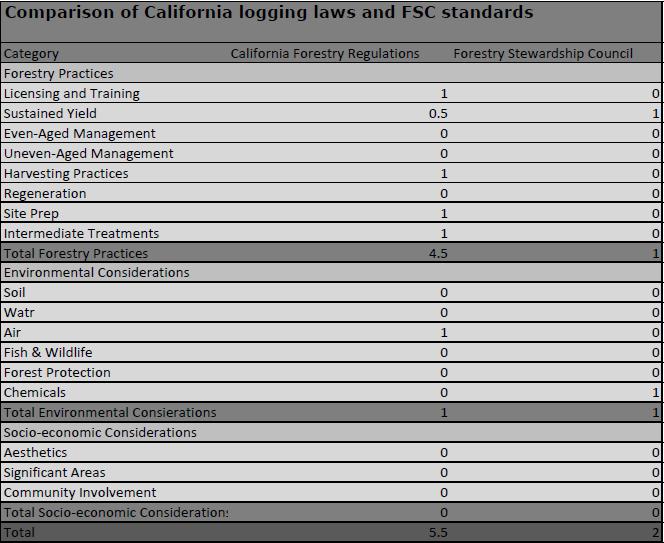| Line 6: | Line 6: | ||
http://www.fsc.org/pc | http://www.fsc.org/pc | ||
==California | ==California Logging Regulations== | ||
A | |||
In California, as of 1999, 45% of the producing forest land is owned by private individuals and companies. (A brief review of timber management on private lands in California.) However to harvest this lumber the owners must have a detailed management plan prepared, which is then reviewed by the state. Often times due to the many regulations for logging in California, the costs to harvest timber on a property are greater than the gain. With the balancing act loggers face to abide by state regulation and turning a profit, wood supply is often imported into California. | |||
The authors of a study on private forestland management at Cal Poly State University-San Luis Obispo say "California forestlands are some of the most legally protected privately owned forests in the world. Multiple layers of federal, state, county and local regulations ensure that timber will be managed in a sustainable manner," but they go on to say that this can lead to micro-managing that may not be good for the forest. (California Forests Highest Requirements in the World) Companies, organizations and individuals continue to fight to either tighten or loosen the regulations. | |||
Currently, as shown in the table below, California forestry regulations are equal to and sometimes exceed the standards of the [[FSC]]). | |||
==Comparison== | ==Comparison== | ||
Revision as of 16:25, 28 September 2010
Introductions
FSC
Forest Stewardship Council (FSC)
California Logging Regulations
In California, as of 1999, 45% of the producing forest land is owned by private individuals and companies. (A brief review of timber management on private lands in California.) However to harvest this lumber the owners must have a detailed management plan prepared, which is then reviewed by the state. Often times due to the many regulations for logging in California, the costs to harvest timber on a property are greater than the gain. With the balancing act loggers face to abide by state regulation and turning a profit, wood supply is often imported into California.
The authors of a study on private forestland management at Cal Poly State University-San Luis Obispo say "California forestlands are some of the most legally protected privately owned forests in the world. Multiple layers of federal, state, county and local regulations ensure that timber will be managed in a sustainable manner," but they go on to say that this can lead to micro-managing that may not be good for the forest. (California Forests Highest Requirements in the World) Companies, organizations and individuals continue to fight to either tighten or loosen the regulations.
Currently, as shown in the table below, California forestry regulations are equal to and sometimes exceed the standards of the FSC).
Comparison
Justifications
This is a brief explanation of why there were differences in the two when comparing them side by side. Emphasis is put on the issues that were different.
Licensing & Training
California requires a licensed Registered Professional Forester to make all management plans as well as licensing for the loggers. This is stricter than the FSC because they only use the term “qualified”, or have adequate training or supervision.
Sustained Yield This one is unique because they are almost equivalent if in California the land is greater than 50,000 acres, but if the landowners own less than 50,000 then the requirements don’t necessarily address as strict as FSC. So California gets .5 to FSC’s 1.
Site Preparation FSC and California both have requirements in regards to site preparation but California’s is more thorough.
Harvesting Practices California’s harvesting practices are more clear cut than the more broad and general FSC standards.
Intermediate Treatments California regulations actually have standards for thinning treatments.
Air California regulations cover air quality issues while the FSC does not mention air quality at all. Chemicals FSC has strict guidelines against the use of many chemicals, and has more intense guidelines than the states regulations.
Conclusions
It appears that when compared quantatively side by side that California logging laws more stringent. But when the number one principle of the FSC standards is taken in consideration, COMPLIANCE WITH LAWS then they would have to be applied, and thus better overall if the FSC standards were in California. But this would not be true if it was FSC certified in another place with less strict guidelines than in California.
References
Gregersen, H. et.al. People and Trees. Washington: World Bank, 1989.
http://www.calredwood.org/pdf/CalPoly+Explainer+Bro.pdf
http://sotsnf.org/pdf/Cal_Poly-Forest_Practices-2003.pdf
www.fire.ca.gov/rsrc-mgt_forestpractice.php
www.fscus.org
